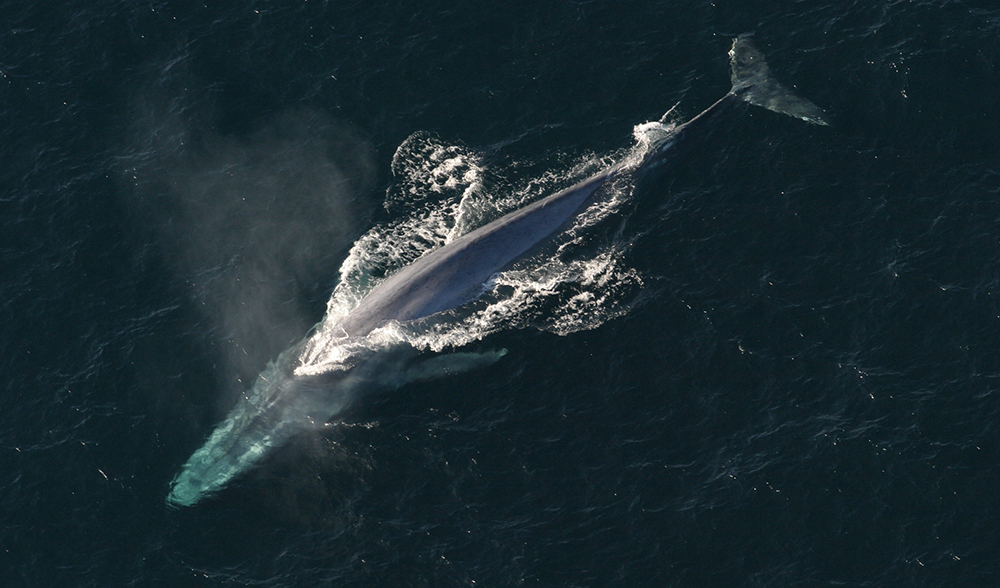BY Catherine R. M. Attard, Luciana Möller, Luciano Beheregaray | March 09, 2016
New research by South Australian scientists could help save Antarctica's blue whales from their "near-annihilation" by whalers during the 20th century.
ANTARCTICA'S CRITICALLY endangered blue whales, the world’s largest animal, are made up of three populations, according to a new DNA analysis.Although the groups occur together when feeding in Antarctic waters, they are genetically distinct. This suggests that the three groups breed in different locations – possibly even different oceans – when they head north in the winter.
If we can find out where they go, and what hazards they face on the way, we will be a step closer to helping them recover from their near-annihilation by whalers during the 20th century.
Hidden giants
It is a daunting task to understand the ecology of the Antarctic blue whale (Balaenoptera musculus intermedia). Even though they can weigh more than 160 tonnes – the heaviest ever known animal – and reach more than 30 metres in length, locating such a rare and highly mobile species in a vast and remote ocean can be like finding a needle in a haystack. And even having tracked them down, it can be hard to deduce anything about their population structure.By comparing similarities and differences in the DNA of individuals, we can tell which individuals are part of the same population and estimate the number of populations. Individuals from the same breeding population are more genetically similar than those from different populations. But we need recently collected DNA samples to do this for current populations.
The standard way to get DNA from a blue whale is to take a biopsy by firing a dart that collects a small piece of skin and blubber, bounces off the whale and floats on the water for collection. It is akin to a pinprick for an animal as massive as a whale.
Long before we started working with blue whales in 2007, expeditions have been carried out under the auspices of the International Whaling Commission to research Antarctic whales. These expeditions involved collecting precious biopsy samples from blue whales and there is now a collection stretching back to 1990.
We were granted access to samples, totalling 142 whales, and used these to create the largest and therefore most powerful genetic data set so far created for Antarctic blue whales. As our research published in Nature’s Scientific Reports shows, we found that these whales fall into three genetically distinct groups.
Where are these populations?
Blue whales, like many other whales, migrate between their Antarctic summer feeding grounds and their winter breeding grounds at lower latitudes.We know Antarctic blue whales feed in the Antarctic, which is where they were hunted during whaling in the 20th century and where the biopsy samples were collected.
We found that individuals from the three populations occur together throughout the Antarctic, although possibly in different proportions in different areas. This is probably because the blue whales need to rove long distances around Antarctica to find the massive amounts of krill that make up their sole food source.
Distribution of samples from the three genetically distinct populations of Antarctic blue whales
We suspect that the three populations go their separate ways when they head north to breed – presumably heading into the three major Southern Hemisphere ocean basins: the South Pacific, South Atlantic and Indian Oceans.
The next step will be to confirm this by finding their breeding grounds. This would involve satellite-tagging whales in Antarctic waters and then watching where they go. More biopsy samples could then be taken at the breeding grounds to confirm which populations are which.
Knowledge for conservation
Understanding the number of populations and their distribution is vital for helping Antarctica’s blue whales recover from 20th-century whaling, which reduced their numbers from 239,000 to just 360 individuals. While they are now protected from whaling, they remain critically endangered.Some populations may be more endangered than others and may face different human threats along their migration routes and at their breeding grounds. Failing to take conservation action at a population level could therefore lead to local extinctions at these locations.
One threat that differs in intensity between locations is noise pollution, such as from seismic surveys for oil and gas as well as shipping activity. These noises can be heard underwater hundreds of kilometres from their source. Whales communicate through sound, so noise pollution can hinder their communications or, in extreme cases, make areas uninhabitable.
Our latest findings, together with our previous work on hybridisation, connectivity and population history of blue whales, provides important pieces in the puzzle of this species. But we are still at the tip of the iceberg in our understanding of the world’s largest animal and in the pathway to their recovery from whaling.
Catherine R. M. Attard is a lecturer in Molecular Ecology at Flinders University; Luciana Möller is an Associate Professor in Marine Biology at Flinders University, and Luciano Beheregaray is Professor in Biodiversity Genetics and ARC Future Fellow, Flinders University.
This article was originally published on The Conversation. Read the original article.
Fonte: http://www.australiangeographic.com.au/news/2016/03/antarctic-blue-whales-split-into-three-populations?adbsc=social_20160309_59118266&adbid=10153447734098339&adbpl=fb&adbpr=100614418338

Nenhum comentário:
Postar um comentário